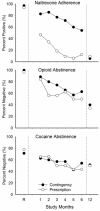Employment-based reinforcement of adherence to oral naltrexone in unemployed injection drug users: 12-month outcomes
- PMID: 25134047
- PMCID: PMC4339630
- DOI: 10.1037/adb0000010
Employment-based reinforcement of adherence to oral naltrexone in unemployed injection drug users: 12-month outcomes
Abstract
Oral naltrexone could be a promising relapse-prevention pharmacotherapy for recently detoxified opioid-dependent patients; however, interventions are often needed to promote adherence with this treatment approach. We recently conducted a study to evaluate a 26-week employment-based reinforcement intervention of oral naltrexone in unemployed injection drug users (Dunn et al., 2013). Participants were randomly assigned into a contingency (n = 35) group required to ingest naltrexone under staff observation to gain entry into a therapeutic workplace or a prescription (n = 32) group given a take-home supply of oral naltrexone and access to the workplace without observed ingestion. Monthly urine samples were collected and analyzed for evidence for naltrexone adherence, opioid use, and cocaine use. As previously reported, contingency participants provided significantly more naltrexone-positive urine samples than prescription participants during the 26-week intervention period. The goal of this current study is to report the 12-month outcomes, which occurred 6 months after the intervention ended. Results at the 12-month visit showed no between-groups differences in naltrexone-positive, opioid-negative, or cocaine-negative urine samples and no participant self-reported using naltrexone at the follow-up visit. These results show that even after a period of successfully reinforced oral naltrexone adherence, longer-term naltrexone use is unlikely to be maintained after reinforcement contingencies are discontinued. (PsycINFO Database Record
Trial registration: ClinicalTrials.gov NCT00149669.
(c) 2015 APA, all rights reserved).
Figures

Similar articles
-
Employment-based reinforcement of adherence to oral naltrexone treatment in unemployed injection drug users.Exp Clin Psychopharmacol. 2013 Feb;21(1):74-83. doi: 10.1037/a0030743. Epub 2012 Dec 3. Exp Clin Psychopharmacol. 2013. PMID: 23205722 Free PMC article. Clinical Trial.
-
Employment-based reinforcement of adherence to depot naltrexone in unemployed opioid-dependent adults: a randomized controlled trial.Addiction. 2011 Jul;106(7):1309-18. doi: 10.1111/j.1360-0443.2011.03400.x. Epub 2011 May 3. Addiction. 2011. PMID: 21320227 Free PMC article. Clinical Trial.
-
Employment-based reinforcement of adherence to an FDA approved extended release formulation of naltrexone in opioid-dependent adults: a randomized controlled trial.Drug Alcohol Depend. 2012 Jan 1;120(1-3):48-54. doi: 10.1016/j.drugalcdep.2011.06.023. Epub 2011 Jul 22. Drug Alcohol Depend. 2012. PMID: 21782353 Free PMC article. Clinical Trial.
-
Extended-release intramuscular naltrexone (VIVITROL®): a review of its use in the prevention of relapse to opioid dependence in detoxified patients.CNS Drugs. 2013 Oct;27(10):851-61. doi: 10.1007/s40263-013-0110-x. CNS Drugs. 2013. PMID: 24018540 Review.
-
Extended-release injectable naltrexone for opioid use disorder: a systematic review.Addiction. 2018 Jul;113(7):1188-1209. doi: 10.1111/add.14180. Epub 2018 Mar 24. Addiction. 2018. PMID: 29396985 Free PMC article.
Cited by
-
Prescription opioid poisoning across urban and rural areas: identifying vulnerable groups and geographic areas.Addiction. 2017 Jan;112(1):103-112. doi: 10.1111/add.13543. Epub 2016 Sep 2. Addiction. 2017. PMID: 27470224 Free PMC article.
-
Abstinence-contingent wage supplements to promote drug abstinence and employment: Post-intervention outcomes.Drug Alcohol Depend. 2022 Mar 1;232:109322. doi: 10.1016/j.drugalcdep.2022.109322. Epub 2022 Jan 20. Drug Alcohol Depend. 2022. PMID: 35077956 Free PMC article. Clinical Trial.
-
Abstinence-dependent dissociable central amygdala microcircuits control drug craving.Proc Natl Acad Sci U S A. 2020 Apr 7;117(14):8126-8134. doi: 10.1073/pnas.2001615117. Epub 2020 Mar 23. Proc Natl Acad Sci U S A. 2020. PMID: 32205443 Free PMC article.
-
Design and implementation of a cohort study of persons living with HIV infection who are initiating medication treatment for opioid use disorder to evaluate HIV-1 persistence.Contemp Clin Trials Commun. 2021 Nov 11;24:100866. doi: 10.1016/j.conctc.2021.100866. eCollection 2021 Dec. Contemp Clin Trials Commun. 2021. PMID: 34825103 Free PMC article.
-
Operant Social Reward Decreases Incubation of Heroin Craving in Male and Female Rats.Biol Psychiatry. 2019 Dec 1;86(11):848-856. doi: 10.1016/j.biopsych.2019.05.018. Epub 2019 May 30. Biol Psychiatry. 2019. PMID: 31326085 Free PMC article.
References
-
- Adi Y, Juarez-Garcia A, Wang D, Jowett S, Frew E, Day E, et al. Oral naltrexone as a treatment for relapse prevention in formerly opioid-dependent drug users: A systematic review and economic evaluation. Health Technology Assessment (Winchester, England) 2007;11(6):iii–iv. 1-85. - PubMed
-
- Anton RF, Hogan I, Jalali B, Riordan CE, Kleber HD. Multiple family therapy and naltrexone in the treatment of opiate dependence. Drug and Alcohol Dependence. 1981;8(2):157–168. - PubMed
-
- Beck AT, Steer RA, Brown GK. Manual for beck depression inventory II (BDI II) Psychology Corporation; San Antonio, TX: 1996.
-
- Broers B, Giner F, Dumont P, Mino A. Inpatient opiate detoxification in geneva: Follow-up at 1 and 6 months. Drug and Alcohol Dependence. 2000;58(1-2):85–92. - PubMed
Publication types
MeSH terms
Substances
Associated data
Grants and funding
LinkOut - more resources
Full Text Sources
Other Literature Sources
Medical
Research Materials

